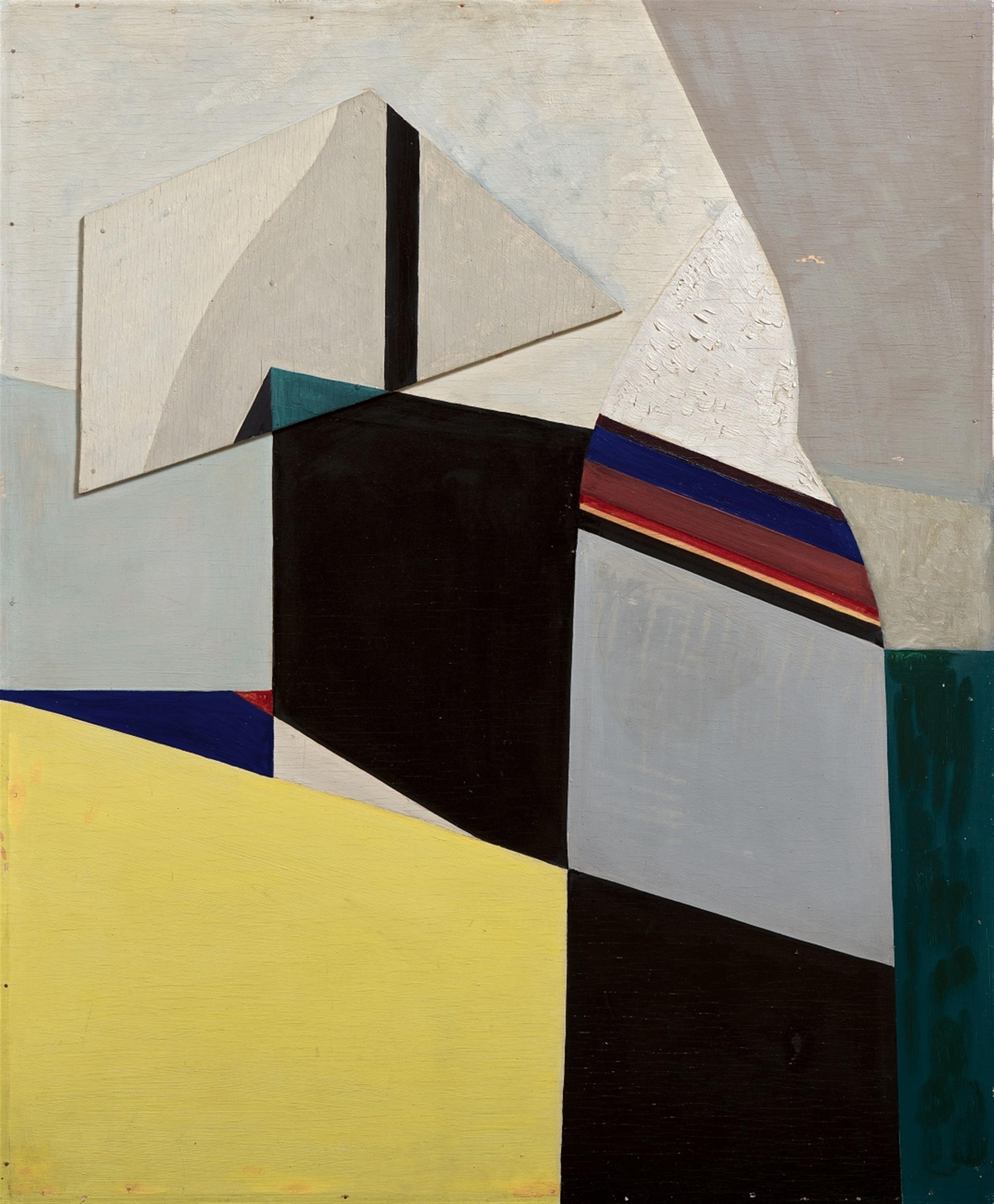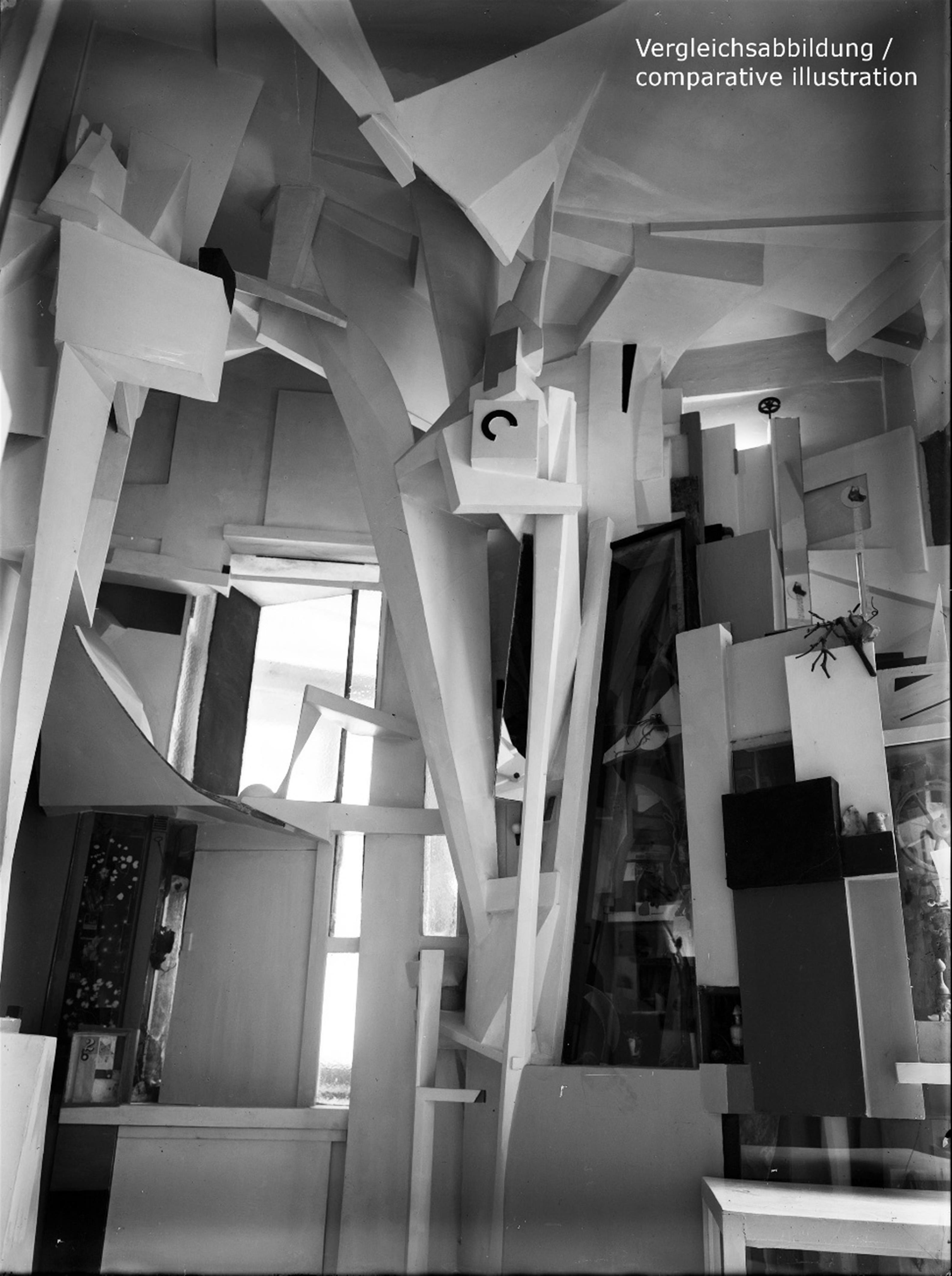Kurt Schwitters
Das Gustav Finzlerbild
1926/1936
Oil on wood on wooden panel (assemblage) 73.7 x 61 cm Framed. Signed, dated, and titled 'Kurt Schwitters 1926/36 Das "Gustav Finzler"=Bild' in pencil verso. - Few minimal losses of colour.
Kurt Schwitters, painter, graphic artist, sculptor, spatial artist and poet is one of the most inspirational post-First World War modern artists. His unconventional, occasionally Dadaistic creativity in connecting things of any materiality into relationships, to translate language into unique poetry, to figure sculptures into mysterious spaces and not least to anticipate Hard-Edge painting with “Das Gustav Finzlerbild”, surprises every encounter with his fascinating work.
Born in Hanover in 1887, Kurt Schwitters began his artistic career in the “traditional” way. He first turned to Expressionism, then discovered Cubism and Futurism, but by the end of his studies in Dresden in 1914 he felt most strongly drawn to the circle of the “Sturm” artists of Herwarth Walden's eponymous gallery in Berlin. There he was to exhibit the first of his “Merz” paintings in 1919, and published an article entitled “Die Merzmalerei” in Der Sturm magazine in the same year. In the “Berliner Börsen-Curier”, Theodor Däubler was to refer to Kurt Schwitters as “the strongest artist, who has achieved a viable form of abstraction” (Theodor Däubler, cited from Ernst Nündel, Schwitters, Reinbek 1981, p. 146).
Schwitters remained in Hanover throughout WWI. He was conscripted in 1917 but soon declared unfit for service and dismissed. The artist felt the rising tides of political upheaval and began searching for a fitting pictorial language to express his kaleidoscope of thoughts. He never allowed himself to be won over by the activists who saw the end of the war as their chance to bring about ideologically motivated political and societal changes. He was only concerned with artistic revolution and opposed its political instrumentalization. Despite this, Dadaist, anti-establishment sentiments remained central to Schwitters' works and texts. Following his thesis: “Dada and Merz are related in their contrariness” (Friedhelm Lach (Ed.), Das literarische Werk, Munich 2005, vol. 5, p. 142), he took on a leading role among the Constructivists in 1921/22. Together with Hans Arp, Theo van Doesburg, Raoul Hausmann, El Lissitzky, László Moholy-Nagy, Hans Richter, Tristan Tzara and many others he moved to Weimar to found the “Constructivist International”, which was aminor slight to the Bauhaus group who were active in the same city. However, Schwitters integrated very little of the severity of his colleagues' Constructivism and geometry into his own collages and assemblages, but it was a significant reference for his life-long “Merzbau” project. Kurt Schwitters, the constructivist and Merz architect, was still a little Dada!
Kurt Schwitters explored both artistic directions throughout his life, and he created the Merz movement in the spirit of Dadaism. “Merz means to create connections, preferably between everything on earth”, the artist once said. For one of his first collages, the artist cut up the text of a bank advertisement reading “Kommerz- und Privatbank” and pasted the part with the syllable “merz” almost exactly in the centre of the framed composition of painted card, paper, newspaper, wood, and chicken wire.
Thus a term was invented to describe numerous similar works, not all of which were given this title, which would become synonymous with his wide ranging and ambiguous works. Schwitters expressively rearranged and painted over found objects, unexplored mediums, and printed text to create his imposing panel images.“The word Merz means fundamental”, said the artist “the combination of all possible materials to create art, and the equal treatment of all materials in terms of technique.” (Lach 2005, op.cit., vol. 5, p. 37).
The artist's perhaps most surreal work was his “Merzbau”, thought to have been started in 1923, the piece would go on to become his life's work. Schwitters continued the project, which was to become something of a leitmotif in his career, in Norway and later in England. A fanciful and confusing structure, like an abstract painting expanding out to fill an entire room, the work encompassed numerous nested shapes, found objects, and relics taken from various contexts and built into the structure or hung in grotto-like niches (see comp. Illus.). Schwitters playfully integrated his wood and plaster forms, which were usually painted in a monochrome white, into the constructivist idiom. He created an alternative to the political reality and concealed in these forms parts of his own biographical world view full of (romantic) memories. The creation of artistic rooms and interiors, perhaps spaces for retreat designed as artistic spaces, marked the beginning of the modern concept of installation art. We find the idea reflected in the grottos and caves of Hans Arp and Hannah Höch, both artists with whom Schwitters was in close contact. The idea of the artistic interior can also be found in the Proun Rooms of El Lissitzky, with their stark experimental constructs designed to bring Suprematist principals into the third dimension.
It was in connection with this idea that the artist created two similar collage-like paintings in 1926. Namely “Das Albert Finzlerbild” (Orchard/Schulz 1358. Albert Finzler is a dentist in Bad Ems. Kurt Schwitters' parents used to spend their holiday there. Reference, with thanks, from Ursula Schulz, Kurt Schwitters Archive, Hanover) and “Das Gustav Finzlerbild” (Orchard/Schulz 1359. Kurt Schwitters received the nickname Gustav Finzler; the name Finzler does not appear in the writings and letters. Reference, with thanks, from Isabel Schulz, Kurt Schwitters Archive, Hanover), presented here. He designed them as three-dimensional modulations of colour fields, possibly based on details from his multi-layered architectural Merzbau constructions, carried out in fields of contrasting colours. Unlike his other collages, which he pasted or tacked together from various materials, "Das Gustav Finzlerbild" is painted. The artist creates the appearance of a room in trompe-l'oeil technique, taking a detailand examining its appearance in paint.
A reconstruction of the Merzbau which was destroyed in 1943 made between 1981-1983 by Peter Bissegger for the Sprengel Museum in Hanover challenges us to imagine Schwitters' construction of coloured cubes piled high to create walls interspersed with niches and roofs. (cf. http://www.merzbaurekonstruktion.com). In “Das Gustav Finzlerbild”, our view could be thought to lead past a green marble column with a simplified capital on the right into a deeper room with a vault, diagonals, and a moulded cornice structure which appears to cut through the walls. The work mirrors the three-dimensional details of the Merzbau, binding them to a painted surface whilst still creating depth through the contrasts of green and white, yellow and black, red, blue, and grey. Fields of varying size press up against each other as if in a relief, supporting each other in an architectural construction identical to that of the historic Merzbau. Does "Das Gustav Finzlerbild” represent a sketch of the Merzbau in colour? We think it does. The observer will find a few such stark Constructivist compositions throughout Schwitters' work, whereby “stark” is not meant in the sense of van Doesburg, Mondrian or Lissitzky. Certainly, the striking architectonic reference of the “Gustav Finzlerbild” reflects the artist's multilayered method and his inventive experimentation for the great theme of the Merzbau assemblage and is thus of such great importance for his work. The fact that “Das Gustav Finzlerbild” was owned by the American artist Leon Polk Smith (1906-1996) for over 20 years since 1956, and has been inspirational for one of the founders of Hard-Edge painting, is a further noteworthy accolade.
Catalogue Raisonné
Orchard/Schulz 1359
Provenance
Oskar Müller und Annie Müller-Widmann, Basel (1935-1952, for storage); Ernst Schwitters, Lysaker, und Edith Thomas, London (1948); Sidney Janis Gallery, New York (1952-1956); Leon Polk Smith, New York (1956-1970/77); Galerie Gmurzynska, Cologne (1977); Private collection, Berlin
Literature
Cercle et carré No, 2, L5.IV.1930, mit Abb.; Abstraction Création Art non figuratif No. 1, 1932, p. 33 with illus.; exhib. cat. X Years of Janis. 10th Anniversary Exhibition, Sidney Janis Gallery, New York 1958, cat. no. 62 (presumably not exhibited); Harriet Janis und Rudi Blesh, Collage. Personalities, Concepts, Techniques, Philadelphia/New York 1962, cat. nor. 74; Werner Schmalenbach, Kurt Schwitters, Cologne 1967, with colour illus. p. 209; Michel Seuphor, L'Art abstrait, Paris 1972, cat. no. 21 with colour illus. p. 145
Exhibitions
Basel 1948 (Galerie d'Art Moderne), Gedächtnisausstellung Kurt Schwitters; New York 1952 (Sidney Janis Gallery), Collage, Painting, Relief and Sculpture by Schwitters, cat. no. 59; New York 1955 (Sidney Janis Gallery), New Arrivals from France. From Picasso to Giacometti; New York 1956 (Sidney Janis Gallery), Kurt Schwitters, cat. no. 28; New York 1963 (Galerie Chalette), Kurt Schwitters, cat. no. 33; New York 1973 (Marlborough Gallery); Cologne 1978 (Galerie Gmurzynska), Kurt Schwitters, cat. no. 30 (adhesive label verso)




